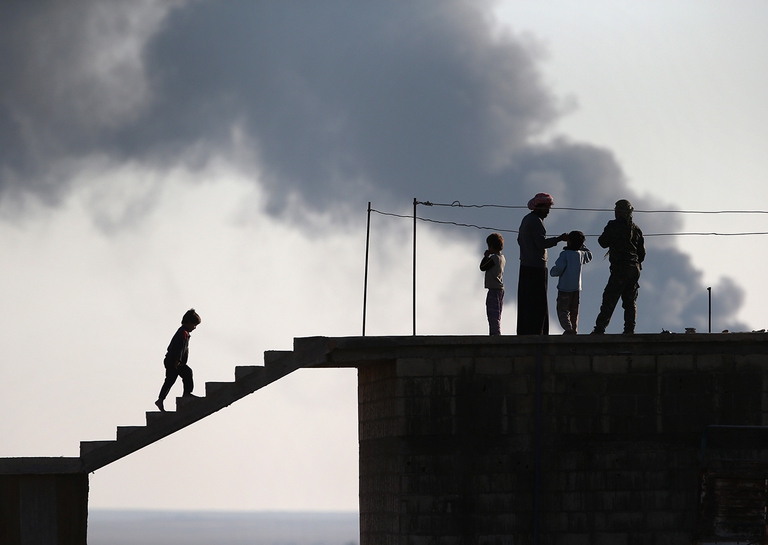
As per tradition after 12 years India held Mahakumbh, the world’s largest spiritual congregation that has been attracting pilgrims from across the globe.
It’s been 5 years since the Syrian civil war began, despite it can no longer be called “civil”. Figures got out of hands and are no precise enough to show the size of the conflict between governmental forces, rebels, terroristic groups and foreign military. The United Nations estimates that 250,000 people were killed and over a
It’s been 5 years since the Syrian civil war began, despite it can no longer be called “civil”. Figures got out of hands and are no precise enough to show the size of the conflict between governmental forces, rebels, terroristic groups and foreign military. The United Nations estimates that 250,000 people were killed and over a million wounded. But these figures have not been updated for months. According to the Syrian Centre for Policy Research, direct and indirect victims account for 470,000.
Out of the 23 million Syrians inhabiting the country before the war burst, 6.5 million abandoned their home becoming internally displaced people, while 4.8 million people crossed the border to reach Jordan – home to one of the world’s largest refugee camps –, Turkey and Europe, as reported by the United Nations High Commissioner for Refugees (UNHCR).
Particularly Jordan, more than any European country, is paying the higher costs to face such emergency. The World Bank estimates that Amman’s government needs 2.5 billion dollars a year to meet the needs of 630,000 Syrian refugees in the country. This means an amount equal to 6% of Jordan’s GDP and one-fourth of its income.
UNICEF, on the other hand, claims that about 3.7 million Syrian children have been in some way affected by the “deadliest and most complex” conflict of our time. Most of these children have known nothing but a lifetime shaped by war. According to the NGO, 1.4 billion dollars would be needed to assist them.
Moreover, UNESCO says that even the Syrian cultural heritage was affected by violence. Nearly all archaeological sites in Syria have been damaged or even destroyed, including the city of Aleppo, home to some of the world’s better preserved medieval castles, and the archaeological site of Palmyra, targeted by terrorists of the Islamic State.
However, there are signs of hope. A cease-fire began on 27 February and, for the first time in 5 years, diplomacy could operate and the humanitarian organisations rescue civilians that have been living under siege for years, in inhumane conditions. It’s a result achieved thanks to the cooperation between the United States and Russia and the mediation of UN envoy for Syria Staffan de Mistura. Nevertheless, the cease-fire excluded those protagonists who made this war uneven, more violent and more difficult to be managed: the Islamic State and the Nusra Front, an armed group affiliate to Al Qaeda in Syria.
Russia’s President Vladimir Putin confirmed his will to take it seriously by announcing the withdrawal of main Russian troops in Syria as of 15 March, the symbolic anniversary of the start of the war in 2011. A decision made to ease dialogue and peace and unexpectedly made together with Damask’s government – still under control of Bashar Al Assad, the one who represents the cause of the war outbreak.
Siamo anche su WhatsApp. Segui il canale ufficiale LifeGate per restare aggiornata, aggiornato sulle ultime notizie e sulle nostre attività.
![]()
Quest'opera è distribuita con Licenza Creative Commons Attribuzione - Non commerciale - Non opere derivate 4.0 Internazionale.
As per tradition after 12 years India held Mahakumbh, the world’s largest spiritual congregation that has been attracting pilgrims from across the globe.
Workers in tea gardens of West Bengal, India, that produces Ctc tea for domestic consumption complain that they have been devoid of basic facilities while political parties make hollow promises during every elections which are never fulfilled.
India is in the middle of the elections, but sadly none of the politicians have uttered a word on man-animal conflict that has been devouring several lives every year.
Manipur, a state in north-east India, is still reeling under the tremors of violence that broke out last year devouring lives and paralyzing the economy.
The government of Tanzania is currently planning to evict more than 80.000 indigenous Maasai people from their ancenstral land
A new UNU-INWEH report on the global bottled water industry reveals the massive scale of this market and the lack of strict quality controls.
Isatou Ceesay founded a social enterprise that is helping to fight plastic pollution and empowering women and young people to gain economic independence.
In 2020, Mihela Hladin made a radical decision that many, in recent times, have probably considered. This is her story, with photos by Matt Audiffret.
The Brazilian government has started evicting illegal gold miners, responsible for the health emergency that has hit the Yanomami people.








